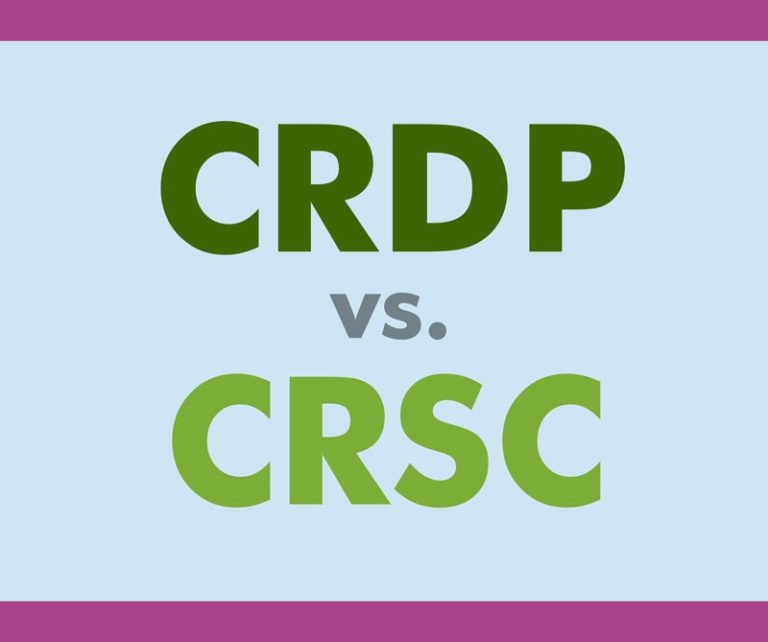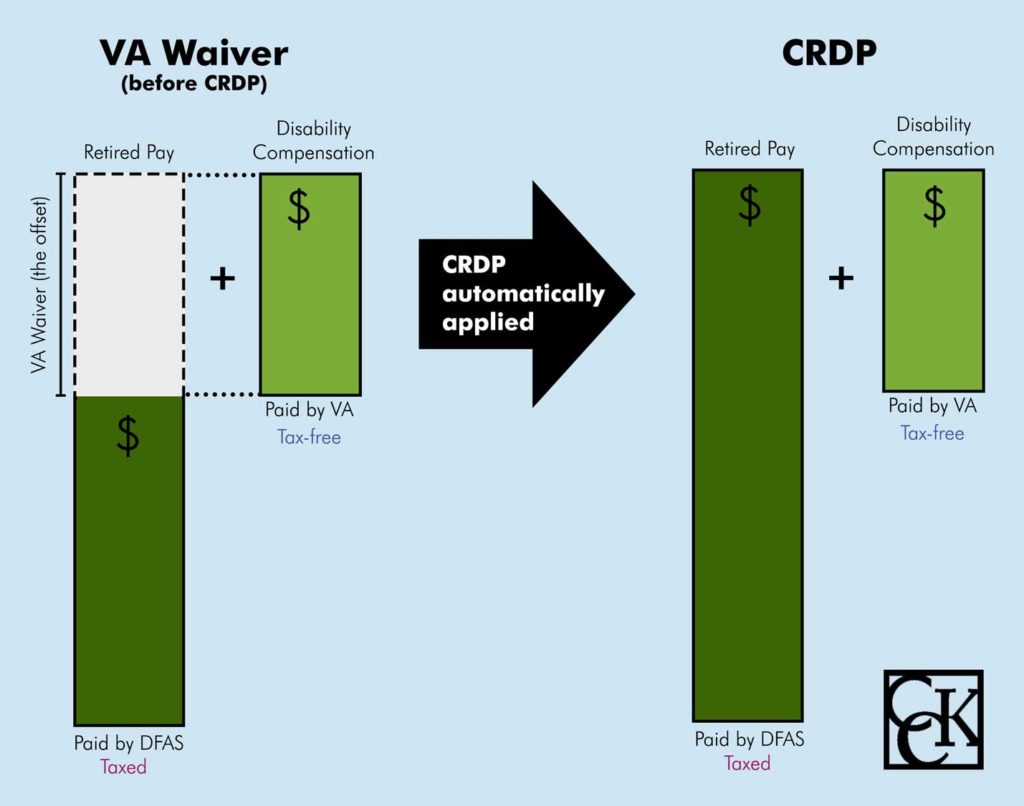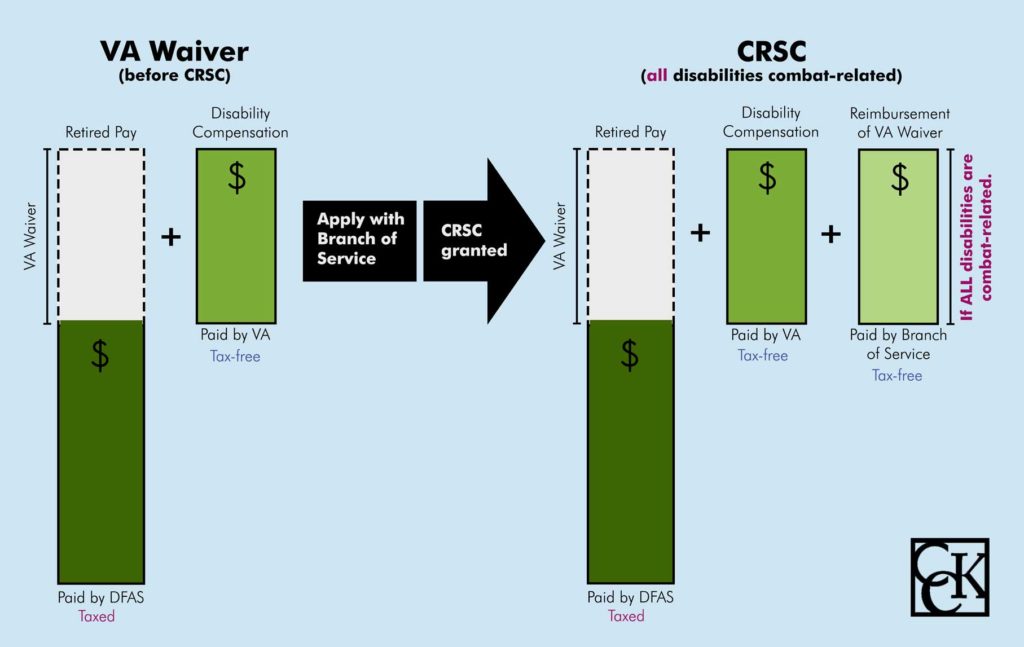CRDP and CRSC: Concurrent Receipt Explained

Before you can understand CRDP and CRSC, you have to understand what happens when a veteran is receiving service retired pay and VA disability compensation at the same time. Veterans who receive retired pay and VA compensation at the same time are typically subject to the government’s “double-dipping” laws. The law stipulates that benefits cannot be duplicated.
To comply with this law, veterans who receive both service retired pay and VA disability compensation simultaneously are required to waive (give up) part of their service retired pay. The amount the veteran receives in VA compensation is subtracted from the amount they receive in retired pay to avoid “double-dipping.” This subtraction is referred to as the VA Waiver.
For a long time, this was the end of the story for retired veterans who were also disabled. But now, certain veterans qualify for what is called “concurrent receipt.” Concurrent receipt is the restoration of service retired pay that has been withheld by the VA waiver. There are two forms of concurrent receipt: Concurrent Retired and Disability Pay (CRDP) and Combat-Related Special Compensation (CRSC).
The two benefits serve the same function – restoring all or part of the VA waiver – but each has different eligibility requirements, application processes, and funding sources. And for veterans who are eligible for both benefits, it can be hard to know which concurrent receipt benefit to choose.
Concurrent Retired and Disability Pay (CRDP)
CRDP restores your service pay simply by eliminating the VA waiver. So, unlike CRSC, you will not receive a separate check for CRDP. Instead, the monthly check you receive from the Defense Finance and Accounting Service (DFAS), the administrator of military retired pay, will be increased from the docked amount (see “VA Waiver” figure on the left) to your full retired pay (see “CRDP” figure on the right).
Because it is a direct restoration of the VA Waiver, CRDP essentially counts as service retired pay.
There is no application process for CRDP. If you meet the eligibility requirements, DFAS will automatically eliminate the VA waiver, restoring your retired pay.

NOTE: For those who had a service disability rating upon retirement
Personnel who retire from the military with a service disability rating may not receive the full amount of the VA waiver. This is because their retired pay is increased due to their in-service disability rating, but the CRDP amount is limited to the portion of their retired pay based only on years of service. So, for these veterans, DFAS will restore the amount of the VA waiver that is based on years of service, but not the amount based on your in-service disability rating.
Eligibility for CRDP
Unlike CRSC, there is no combat-related factor for CRDP eligibility. To be eligible for CRDP, veterans must
- be receiving retired pay and VA compensation,
- be a 20-year (or more) retiree,
- have a service-connected disability rated 50 percent or more.
Unfortunately, medical retirees (Chapter 61 retirees) with less than 20 years of service are not eligible for CRDP. And again, if you meet the above requirements, CRDP will be applied automatically and your VA waiver will be eliminated.
Combat-Related Special Compensation (CRSC)
CRSC is a version of concurrent receipt for veterans whose disabilities are combat-related. Unlike CRDP, CRSC does not eliminate the VA waiver. The VA waiver (an amount equal to your total VA compensation) will continue to be subtracted from your service retired pay. But CRSC reimburses all or some of your VA waiver in a separate check from your branch of service.
Thus, veterans receiving CRSC will get three separate checks each month. From DFAS, a check for service retired pay with the full VA waiver amount subtracted; from VA, a check for your full VA compensation; and from your branch of service, a check for your CRSC reimbursement.
If, however, your VA compensation amount is greater than your total retired pay, you may only get 2 checks each month: one for your VA compensation and one for your CRSC payment. You would not receive a retired pay check in this case because the VA waiver, which is subtracted from retired pay, completely eliminates the retired pay. And, unlike CRDP, CRSC is a reimbursement of your VA waiver rather than a restoration of your VA waiver in the form of retired pay.
Because it is not considered retired pay, the CRSC payment is tax-free.
NOTE: For those who have some service-connected disabilities that are combat-related and some that are not
It is important to note that CRSC may not reimburse the full amount of the VA waiver if only some of the veteran’s service-connected disabilities are combat-related. For example, the veteran’s branch of service may determine that only 40 percent out of your 60-percent overall rating is considered combat-related (because of the way your disabilities were incurred), in which case they would reimburse only the amount of VA compensation you would receive for a 40-percent rating.


NOTE: For those who had a service disability rating upon retirement
Similar to CRDP, personnel who retire from the military with a service disability rating may not be reimbursed the full amount of the VA waiver in their CRSC payment. Retired pay is based on years of service (and pay-grade) for most veterans. But for those who have a disability already rated (in service) when they retired, an additional amount is added to their retired pay beyond what they would have received solely for their years of service. The CRSC amount, however, is limited to that portion of their retired pay based only on years of service. So, for these veterans, the VA will reimburse the amount of the VA waiver that is based on years of service, but not the amount based on an in-service disability rating.
Eligibility for CRSC
Unlike CRDP, CRSC is not automatically applied to eligible veterans. For CRSC, you must apply to your branch of service. You branch of service determines what proportion of your VA disability rating is combat-related and award you a CRSC rating. That CRSC rating determines the amount of additional money you will receive each month.
Eligibility criteria differ slightly for each branch of service, mostly in how they interpret the term “combat-related.” But for all branches of service, veterans must be receiving both service retired pay and VA disability compensation. Unlike CRDP, there is no minimum rating requirement for CRSC to kick in. Veterans with 0% (non-compensable) ratings are not eligible because they are not receiving VA compensation and thus have no retired pay offset.
Below you will find links to the website for each branch of service that explains their eligibility requirements, how to apply, and what documentation you need to include with your application. Each site also has downloadable CRSC application forms and the appropriate mailing address for that branch of service.
Choosing CRDP or CRSC
You cannot receive CRDP and CRSC at the same time. If you are eligible for both CRDP and CRSC, there are two ways you can go about selecting one or the other:
Automatic selection of the greater amount. If you are already receiving CRDP and then become eligible for CRSC (after applying with your branch of service), DFAS will assess which of the two programs will pay you the greater amount. They will automatically pay you this greater amount. Many veterans will choose to stick with the benefit that pays the greater amount, and this requires no additional action. But there are a few reasons you may want to select a different program (see “Factors to consider” below).
Voluntary switch during open season. If you prefer to switch programs after DFAS’s initial assessment, you will have the opportunity to do so once a year. Every December, DFAS will mail you an open-season election letter. The letter contains information about the different amounts you would receive under CRDP or CRSC, and the potential impact of each on your taxes. You will be able to select one benefit or the other on the form included in the letter. If you would like to continue receiving the benefit you currently receive, there is no need to fill out the form.
Open season may be particularly important if your VA ratings or CRCS rating (i.e. what percentage of your disabilities are considered combat-related) changes mid-year. A change in ratings (increase or decrease) could make one of the benefits more valuable than the other.
Factors to consider
When given the opportunity to choose CRDP or CRSC, it can be challenging to make an informed decision. Many veterans will simply want to accept the benefit that will give them the greater amount of money, but there are a few other factors that should be considered, especially if your CRDP and CRSC amounts are close to equal.
Below is a summary of the differences between CRDP and CRSC that might influence your decision.
| CRDP | CRSC | |
| Full concurrent receipt?
| Yes | Only if ALL of your disabilities are combat-related* |
| Required minimum VA disability rating
| 50% | 10%
|
| Application required?
| No – automatically applied. | Yes – with branch of service. |
Taxable? | Yes | No |
Subject to division by divorce courts (USFSPA division)? | Yes | No |
Retroactive payments?
| Yes – May go back to June 1, 2003 | Yes – May go back to June 1, 2004 |
* Otherwise, your branch of service will determine what percentage of your disabilities are combat-related and you will be reimbursed for only that percentage.
Guard and Reserve Issue: Medical Retirees
Regular Guard and Reserve retirees cannot receive retired pay until age 60. So, even if these veterans are receiving VA compensation before age 60, they will not be eligible for CRDP or CRSC until they turn 60 and start receiving retired pay and VA compensation simultaneously.
For Guard and Reserve members who are medically retired before reaching age 60, however, eligibility for CRDP in particular can be confusing. Even though medical retirees do receive retired pay before age 60, certain medical retirees will still not be eligible for CRDP before age 60. The reason comes down to the difference in how “years of service” are calculated for regular Guard and Reserve retirement and for medical retirement.
To be eligible for CRDP, veterans must have 20 or more years of service. For regular Guard and Reserve retirement, your total “years of service” are calculated by adding your “active years” (on active duty) with your “drilling years.” For medical retirement, your “years of service” are calculated based only on your active duty years.
So, for medical retirees who have less than 20 years of active service, but 20 or more years of combined drilling and active service, eligibility can feel complicated. Unfortunately, the medical retirees in this “gray area” are not yet eligible for CRDP, but will become eligible when they turn 60. This is because, under medical retirement, the veteran is considered to have less than 20 years of service, so DFAS and VA make the same assumption for CRDP purposes. At 60, the veteran can include the total time for their Guard and Reserve retirement (active years and drilling years), and would be considered to have 20 or more years of service, thus meeting the eligibility criteria for CRDP.
Tax Issues
Disclaimer: The following section of this post does not, and is not intended to, provide tax or accounting advice. Readers should consult their tax advisors concerning the application of tax laws to their particular situations.
CRDP is taxed. CRSC is not. These simple facts can lead to some pretty complicated tax issues, especially when veterans are awarded CRSC or their VA ratings change mid-year. When VA or DFAS approve these changes, the changes are often implemented retroactively. So, as a simple example, a veteran whose overall VA rating was increased from 50% to 70% might receive a retroactive payment of all the benefits he or she would have received, back to an effective date that the VA determines.
When a veteran is receiving CRDP and is then awarded CRSC, CRSC benefits are often retroactively applied. But the retroactive implementation of CRSC also means a retroactive removal of CRDP. Because the CRDP benefits were taxed but CRSC is not, veterans may be able to claim a federal tax refund for the year in which CRSC was awarded and for the years it was retroactively applied.
About the Author
Share this Post

